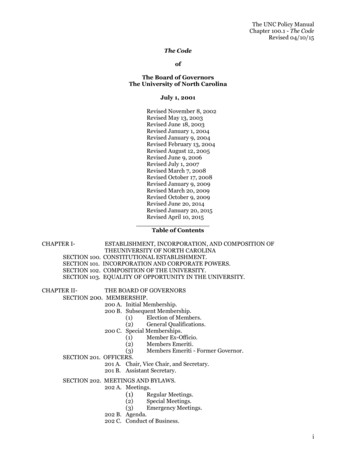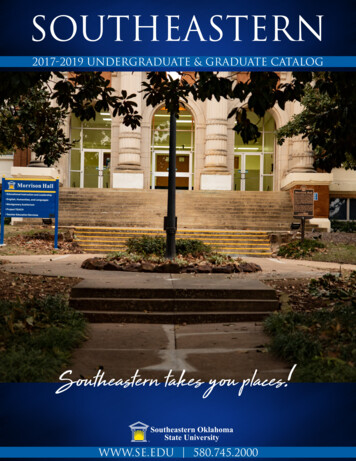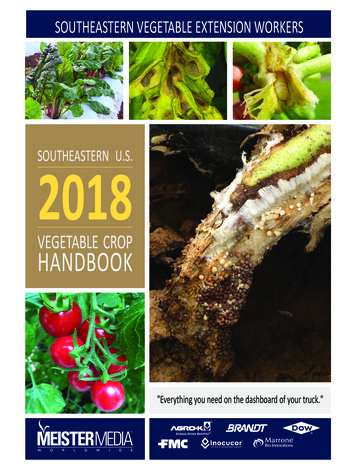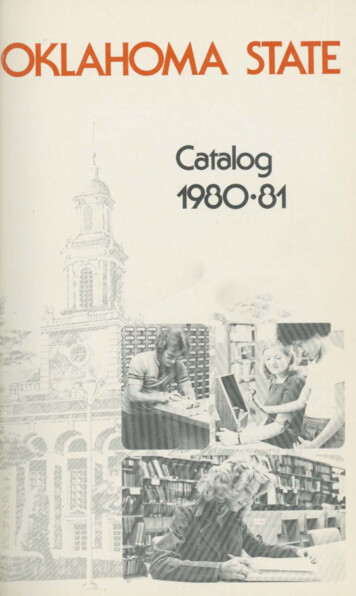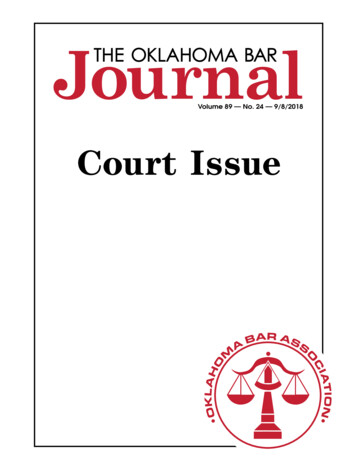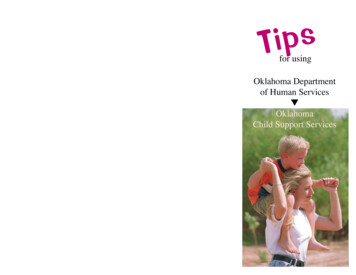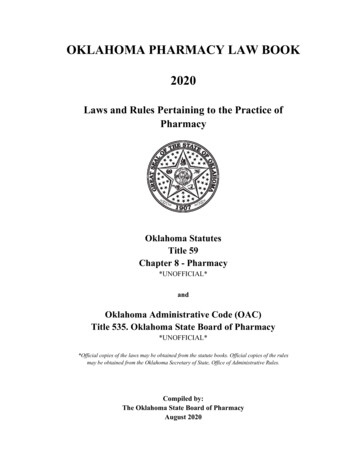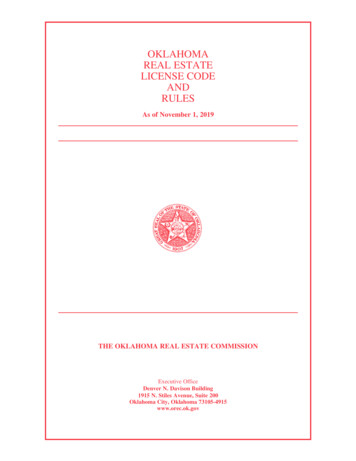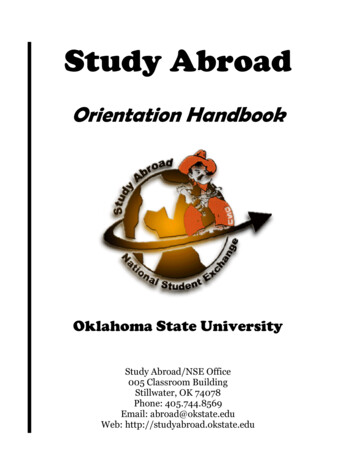
Transcription
Study AbroadOrientation HandbookOklahoma State UniversityStudy Abroad/NSE Office005 Classroom BuildingStillwater, OK 74078Phone: 405.744.8569Email: abroad@okstate.eduWeb: http://studyabroad.okstate.edu
INDEXThe Study Abroad Orientation Handbook is divided into sections that focus on the major areasof concern that most students encounter before, during, and after a study abroad experience.ACADEMIC CREDIT2FINANCIAL AID3PRACTICAL MATTERS5SAFETY & EMERGENCY10CULTURAL ADJUSTMENT25PHONE NUMBERS & ADDRESSES26CHECKLIST27NOTES281
ACADEMIC CREDITWhether you are studying abroad on a reciprocal exchange or an affiliated /approved program, the courses you plan to take abroad mustbe pre-approved, their OSU equivalence established, and their applicability to your degree program determined.RECIPROCAL EXCHANGEReciprocal Exchange enables you to pay tuition and fees to Oklahoma State University while studying abroad at a host university. Youpay all other charges such as room and board, books and supplies, at your host institution.You are enrolled at OSU in a holding number designated as “Study Abroad 3090,” specific to your academic college.Once abroad, you enroll in specific classes at your host university. The classes taken abroad replace “Study Abroad 3090” credits whenyou complete your studies and the courses are posted on the OSU transcript.To efficiently and successfully complete the enrollment process and to receive credit for your work abroad, please carefully follow theReciprocal Exchange Timetable and observe the deadlines for submitting required documents. The Timetable was developed to helpyou organize your time; failure to observe deadlines may result in your dismissal from the exchange.AFFILIATED/APPROVED PROGRAMSAffiliated/approved programs encompass programs offered by US universities and study abroad organizations as well as directenrollment. The process of pre-approval of courses is similar to that for reciprocal exchange. You are enrolled at OSU in the holdingnumber TEMP 1777-691. You do not pay OSU tuition and fees, but pay the program fees of the host institution.SELECTING CLASSES AT YOUR HOST INSTITUTIONIdeally, you select all the classes you may consider taking abroad before you leave OSU. The classes are then evaluated for their OSUequivalence using the Course Equivalency Evaluation form. You can then use this evaluation to help select classes when you enrollabroad. In some cases, you must wait until you are on site before knowing which classes will be available.You must complete the Course Equivalency Evaluation Form and obtain the appropriate signatures from your college academic advisingoffice, the Financial Aid Office, the Study Abroad Office, and the course evaluator before you are authorized to enroll or before you haveconfirmation that your courses will transfer back to OSU as you expect for affiliated/approved programs.VERIFYING YOUR ARRIVAL AND ENROLLMENTBetween the first and fifth day of classes at your host university, you are expected to fax your Enrollment Verification and ArrivalReport to the Study Abroad Office. Do not fax the form earlier, as it won’t be accepted. Your federal financial aid will be disbursed assoon as the Enrollment Verification has been received and evaluated. The Enrollment Verification and Arrival Report must be submittedno later than the Friday of the first week of class. You will be notified by e-mail of the evaluation of your courses. This notification willenable you to make informed decisions about dropping or adding classes.You are responsible for all the courses you report on the Enrollment Verification and for any changes you make within six weeks afterthe date classes begin at your host university. Make certain the number of host university credit hours is accurately indicated for eachcourse. If there is a discrepancy between the courses and number of credit hours reported on the Enrollment Verification and the officialacademic record (transcript), you must provide an explanation of the discrepancy from your host coordinator who has previously verifiedthe accuracy of the credits, so we are ensured of having valid information.MAKING CHANGES IN YOUR ENROLLMENTUse the Drop/Add Notification to make course schedule changes. Making changes in your schedule is allowed through the Friday of thesixth week of classes at your host institution. Your final schedule of classes will be determined by the Verification of Enrollment andany subsequent Add/Drop Notifications received by the six-week deadline. You will be responsible for payment of fees for the totalhours of enrollment based on these verifications. In addition, you may not add a course after the six week deadline. You may drop aclass after the deadline, however, you will receive a grade of “W” and you will be charged for the course, just as you would be if youwere in residence at OSU.If a course appears on the official academic record from your host university that was not reported on your Enrollment Verification orAdd/Drop Notification, you will not receive credit for the course. If a course that appears on your Enrollment Verification or subsequent2
Add/Drop Notification does not appear on the official academic record from your host institution, you will receive an “N” grade,meaning no grade reported. You will still be charged for the credit hours.If you add any courses that were not previously evaluated, you should provide a description of the course in English. Neither the StudyAbroad Office nor the evaluator will be able to translate course descriptions for you.OBTAINING AN OFFICIAL ACADEMIC RECORD (TRANSCRIPT)At the end of each term of your studies abroad, please ask that an official academic record be sent to the Study Abroad Office. If yourhost university issues an academic record only once a year, please let us know so we can note the exception. Your financial aid will bedisbursed when you demonstrate that you have successfully completed the previous period of academic work.If you think you will not receive an official academic record promptly and that your financial aid for the subsequent semester may bedelayed because you are not able to provide a transcript, use the Academic Progress Report to record the signatures from yourindividual professors indicating you successfully completed your classes. The form can temporarily serve as an official transcript;however, the official document must be provided within a reasonable time.Remember, it’s in your own best interests to be as organized and as accurate as possible! The forms were designed to make the processmore efficient and easy to use. It’s your academic record that will be affected. We have to work together as a team to try to coordinatetwo different academic systems. The better organized you are, the more time you will have to spend absorbing the host culture!FINANCIAL AIDWhen you decided to Study Abroad, one of your major concerns was probably the cost - the cost of the program as well as thecost of traveling to, and living in, another country. If you are eligible, you may use financial aid to help pay for your study abroadexperience. REMEMBER, TO BE ELIGIBLE FOR FINANCIAL AID, THE COURSE WORK YOU TAKE WHILE ON ASTUDY ABROAD PROGRAM MUST TRANSFER BACK AND APPLY TO YOUR DEGREEYou may already receive financial aid to assist you with educational expenses or you may plan to apply for financial aid to help with thecost of study abroad. The following checklist will help you remember the necessary steps to take. If you plan to apply your existing federal financial aid to study abroad, contact the Office of Scholarships and Financial Aid at (405) 744-6604, 119 Student Union.One of the early steps you need to take is to get a cost of living estimate from your host university. The Study Abroad office can help you with this step.To apply for Federal/ State Financial Aid complete the Free Application for Federal Student Aid (FASFA) - paperapplications are available in 119 Student Union or in the Student Services Offices of the individual OSU Colleges. An electronicapplication can be completed by using FAFSA Express in the Office of Scholarships and Financial Aid, 213 Student Union, or byusing FAFSA on the Web at www.fafsa.ed.gov.1. Provide the required supporting documents (U.S. Income Tax Returns, for example) as requested by the Office of2.Scholarships and Financial Aid;Review your Financial Aid Award Letter and accept or decline offers. Return the signed award letter to 119 StudentUnion. If you are accepting a Federal Loan, you will need to have completed a Master Prom Note (MPN) using yourFAFSA pin number at http://dlenote.ed.gov and entrance interview at www.dl.ed.gov. Check with the Bursar – StudentLoans, 113 Student Union, telephone (405) 744-6447, regarding the processing or your promissory note if you areaccepting a Federal Perkins Loan.3.If you are a previous borrower in any of the following loan programs, you should contact the holder of your loan toensure you have complete deferment forms and any other information required to keep you in good standing in theseprograms:3
-Federal Perkins Loan-Federal Subsidized or Federal Unsubsidized Stafford Loans-Federal Ford Direct Subsidized or Unsubsidized LoansIf you hold scholarships or plan to apply for scholarships .1. Check with the awarding Agency/Department to see whether you can use your scholarship money to study abroad. 2.Apply for the following OSU programs: Continuing University Fee Waivers – application is available online beginning(approximately) December 1 or via the Web at www.okstate.edu/finaid. Application deadline is March 1; departmentalScholarships may be offered specifically for study abroad. Check with the individual College Student Service Office;freshman and Transfer Fee/Tuition Waivers – apply using the OSU Application for admission and filling out thescholarship application. Check with Office of High School and College Relations, 219 Student Union, or the Office ofScholarships and Financial Aid, 119 Student Union.Important Facts About Federal Financial Aid Disbursements for Study Abroad Students Disbursement of Federal Student Aid cannot occur until the first day of attendance at the host institution. This attendance must beconfirmed by faxing official documentation to Study Abroad Office. We will forward this information to the Office ofScholarships and Financial Aid Disbursements are divided by the type of terms at the host institution, for example, into blocks, quarters, or semester. Yourfinancial aid may be disbursed in increments that differ from the traditional two-semester academic year. If you are studying abroad for more than one block, semester or quarter, the subsequent term’s financial aid cannot bedisbursed until you submit the grades for completed coursework.Official grades for completed coursework at the host institution must be received before disbursement will be made to studentsreturning to OSU for subsequent terms within the current academic year (for example, spring or summer) or for the nextacademic year for students returning to the U.S. in late spring or summer.In general, federal financial aid will be dispersed into your Bursar’s account when you confirm you are enrolled and classes have begunat your host university. Any surplus payment after tuition and fees will be refunded to you as you have designated: direct deposit, checkto parents, etc.If you are using financial aid to study abroad, you will receive a financial aid checklist and statement of responsibility. The financial aidchecklist and statement of responsibility provide further details and cautions regarding financial aid.KEY FINANCIAL AID POINTS: Linda Millis, financial aid specialist for Study Abroad at Oklahoma State University, is located in the Office of Financial Aid,119 Student Union, e-mail: linda.millis@okstate.edu. Before your aid will be released on the first day of class abroad, you must provide the Financial Aid office with the following A signed course evaluation form A signed statement of responsibility A signed verification of enrollmentMake certain you maintain full-time student status Undergraduates: 12 hours per semester Graduates: 6 hours per semester Scholarship recipients: 28 hours per academic year or other specific requirements BEFORE you leave, be sure to request from your host university that your transcript be forwarded to the Study Abroad Office.You must demonstrate that you successfully completed the previous semester and that you are presently enrolled in classes(enrollment verification) before your financial aid will be released for future semesters.NOTE: Make sure you sign all the promissory notes before you leave OSU and that you have arranged for direct deposit fromyour bursar’s account.4
PRACTICAL MATTERSFrom the passport to packing Students must have a signed, valid passport (and visas, if required). Students studying abroad must be sure that they have the proper visato study there; a visitor’s visa or entry without an appropriate visa may not allow one to study. Students should remember to fill in theemergency information page of their passport. It is a good idea for relatives of students abroad to obtain and maintain a valid passport as well, in case of an emergencyrequiring them to travel.Students should make copies of their passport's data page and any visas. They should keep a copy separately from the originalswhile traveling and leave one at home with their family and with their student advisor. This will help to obtain a replacementpassport in the event the passport is lost or stolen.Passports and VisasIf you do not have a passport and have not begun the application process, get busy! The months from January to August are the busiestfor passport offices, so allow lots of time for processing, especially if you are studying abroad for the summer or fall semester.Student Visa ApplicationsIf the country in which you will be studying requires a student visa, get it as soon as possible. Do not procrastinate, or you may notreceive your visa in time. You will need an acceptance letter from your host institution, passport, and other documents as required by thehost country’s consulate. Remember to send the visa application and passport by certified mail or Fed Ex so you can track thedocuments.Find out if you will need a visa by checking the foreign entry requirements of your host country:http://travel.state.gov/travel/cis pa tw/cis/cis 1765.htmlInternational Student I.D. Card (ISIC)This card is invaluable to student travelers because it makes you eligible for special privileges, student discounts and travel bargains--thatmeans lower-price air fares and accommodations; sometimes admission is reduced or free to museums, theaters, and cultural or historicsites. The ISIC card also gives students some emergency evacuation and repatriation insurance coverage. Please review the materials thataccompany the card.You should get the card before you leave the U.S. but be aware that it expires one year from the date of issue. Here on the OSUcampus the card is available through the Study Abroad Office.Remember to bring the following: One passport-size photo with your name written on the reverse side Your OSU school I.D.The ISIC card costs 22.00 and can be charged to your bursar account or paid with check or cash.5
Medical & Travel InsuranceMake sure to have a complete physical before you go. At your doctor's office, do the following: Check that all shots are current, particularly the following: measles, rubella, polio, mumps, diphtheria, tetanus, and whoopingcough. Check on any immunizations needed for vacation travel.Get copies of all prescriptions (including for glasses or contacts), and be sure to request that any prescriptions include thegeneric names of drugs, since U.S. brands may not be available (or may be expensive). If you rely on any over-the-counter U.S.medicines (Advil, Tylenol, etc.), take them with you in a quantity sufficient for your stay.Have your doctor write a specific medical history if you are required to take any medications that might be consideredsuspicious narcotics in a foreign country. Do not assume that you know the difference: ask your doctor about this specifically.Please review the Centers for Disease Control and Prevention Web site for updated immunizations information: http://www.cdc.gov/.You should also schedule a dentist appointment before you go, if possible. Try to do this well in advance, so that any necessary dentalwork can be completed before your departure.Medicine and PackingRemember to keep all medications (even common things like Tylenol or Advil) in their original containers with any prescriptions clearlymarked. If you have allergies or need medication regularly, be sure to pack it in your carry-on luggage rather than in baggage that will bechecked. You should have your carry-on luggage with you at all times, which will reduce the risk that necessary medication will be lostin transit or stolen.Bring an extra pair of glasses or contact lenses. (Always bring spare glasses, even if you think you'll never need them.) Also bring alegible copy of your prescription. Contact lens wearers should bring extra contact lens solution and a 220/110 volt converter if you useheat disinfectant.Medical insurance is required of all students participating in an OSU study abroad program. You must be covered by medicalinsurance while abroad, including during travel to and from the program. Be sure that your present insurance will be in effectwhen you are overseas!Every year, hundreds of students become ill or suffer injuries overseas. It is essential that students have medical insurance that wouldcover a medical emergency abroad. Visit the Centers for Disease Control and Prevention's web site at http://www.cdc.gov/.Discuss the following items with your insurance company: eligibility requirements duration of coverage the dollar limit of the policy, per incident and in total emergency evacuation and repatriation coverage and procedures cost of premium coverage for accidents contact and procedures for making claims related benefits such as 24-hour emergency contact, doctor referral services, etc.Take along some claim forms from your insurance company so that you'll have them on hand if they are needed. Be sure that youunderstand what your insurance company's method of reimbursement will be while you are overseas--in many cases you will be requiredto pay the total cost of any treatment and then wait for reimbursement. It is wise to discuss a plan with your parents for receivingemergency money while overseas, if your plan requires you to pay for medical treatment up-front, even if you will eventually bereimbursed by your insurance.The following telephone numbers and websites are listed as resources for insurance companies specializing in travel and foreign study.You should confirm with your current or prospective provider that coverage for you is not limited or excluded while you are out of thecountry. Some companies listed below offer only health insurance or medical assistance programs; others provide comprehensivecoverage including health, cancellation and baggage insurance. MAKE SURE YOUR PLAN INCLUDES EMERGENCY MEDICALEVACUATION AND REPATRIATION OF REMAINS. Another option to include is provision for and inclusion of pre-existingconditions. Participation in a reciprocal exchange or study abroad program requires that you have adequate coverage abroad in the eventof a medical emergency, so please take the time to consider and review your policy status. Inclusion of companies on this page does notsuggest endorsement by Oklahoma State University or the Study Abroad Office.6
*This has been reviewed by Oklahoma State University Office of Student Health Insurance. Brochures are available in the OSUStudy Abroad Office.OSU’s Insurance – for Reciprocal Exchanges OnlyHTH StudentsStudy Abroad state.edu/UHS/uhsstuins.htm*Scholastic Overseas Services (SOS)SOS Scholastic Traveler Membership and OptionalMedical & Travel ltural Insurance Services International g Money AbroadYou will want to plan your financial needs for study abroad carefully. Take traveler’s checks and cash to tide you over for a few days or aweek upon arrival in the host country. Some options for handling money include using Automatic Teller machines (ATM), traveler’schecks, cash advances on credit cards and wire transfers. Some of these can be complicated and expensive so you should ask yourprogram staff to recommend the most effective means in the host country. You will probably spend relatively large sums of money inyour first few weeks abroad as you learn your way around a new setting and buy what you need to get settled. It takes a few days toadjust to a new currency and understand its value. Automatic Teller Machine (ATM) CardWithout a doubt, the most convenient, secure, and economical way to keep yourself supplied with cash in the local currency is by usingan ATM debit card (or check card), preferably with a Visa or MasterCard logo, and with a four-digit PIN code. With such a card you candraw money out of a checking account in your home bank in the U.S. (but not out of a savings account). You will receive the commercialexchange rate, which is always better than the tourist rate, and you will not be tied down to banking hours. There is a limit to the amountyou can draw out on any one day--usually 300, and your home bank will usually charge a fee for each transaction, typically somewherebetween 1 and 3. Therefore, it makes sense to take out the maximum allowable amount each time. And of course, if you are going toneed large amounts of cash, you will need to do some planning ahead. It is also important to know how much money you have in yourchecking account back home and to keep track of your cash transfers. If you plan to use an American Express card for accessing yourchecking account, you need to sign up with American Express for that service ahead of time at (800) CASH-NOW. The service isultimately more expensive than using a debit or check card with a Visa or MasterCard logo. Since you could lose your ATM card or haveit stolen, it is important to have a backup financial plan for emergencies. The most sensible one is to take a few hundred dollars intraveler's checks. Traveler’s ChecksTravelers checks are a good means of transporting money abroad because you are given a record of the check numbers and stolen checksare replaced. Keep check numbers recorded in a safe place. Traveler’s checks are especially useful if you plan to travel to severalcountries with different currencies. American Express will cash American Express traveler’s checks free of charge. Banks usually offergood exchange rates, but may charge a commission. Hotels, railroad stations and commercial “exchanges” tend to give expensive ratesand charge the highest commission. Traveler’s checks are a safe way to keep emergency funds. Credit CardsCredit cards often give you the best exchange rates for purchases, but many small restaurants, stores and cafés do not accept them. Youshould also find out which card is most commonly accepted in your host country. When using a credit card abroad, always verify theamount on the bill and keep your receipts. Notify your credit card company of your study abroad plans to avoid the cut-off or blockingsystems activated by out of pattern charges to your card. Purchases made overseas are not subject to U.S. purchase protection policies fordamaged or stolen goods. Some credit card companies charge high interest rates immediately on a cash advance unless there aresufficient funds in your credit card account. Wire TransfersWire transfers are yet another option. Banks, American Express offices and commercial agencies will wire money to a bank account oragent abroad in 3-4 business days. There may be a large transaction fee both to send and to receive the money. Ask about these fees bothat home and abroad before wiring money.7
PackingNearly everyone agrees that you can't take as much as you'd like to. Once you've dragged your bags across airports, bus terminals, trainstations, up and down stairs, over cobbled streets and uneven sidewalks, you'll probably wish that you had listened to the “less is more”advice. Analyze your travel plans: How often do you have to change vehicles (airport to train station, train to bus, and bus to taxi)? Howmuch flexibility will you have about leaving things behind while you travel during vacations? If you plan to see the country you'revisiting at either the beginning or end of your program, you will probably have to carry everything with you, so you should take less.The standard advice for choosing how much stuff to take is as follows: lay out all the clothes you plan to take and then cut the amount inhalf. This should give you the right amount!OSU's programs are all located in areas of varying weather. Temperatures can change dramatically overnight or even in the course of asingle day, so the best rule for choosing a wardrobe is to select items that can be interchanged and layered when you need more warmthand dressed up or down as the occasion warrants.Past participants said that in England, France, and Spain students dress up, both for class and to go out. One year students will tell us thatEuropean style is to wear only black. The next year they will say Europeans wear all types of clothes and colors. It is hard to say what thestyle will be when you are over there, but make sure the clothes you pack are comfortable and that you like them. You can always buynew clothes when you arrive. Students have commented that there are good secondhand clothing stores all through Europe.Some suggested clothing items: solid colored items that can be worn with at least two or three outfitspractical, comfortable clothes that can be layered for warmtha few clothes for each seasonone dressy outfit that can be worn in any season (a dress for women, sports jacket and slacks for men)slippers (most floors will not be carpeted, and, in Europe, bare feet are considered offensive)flip-flops or shower shoes for traveling and for the beacha bathing suit or twoa raincoat or pull-over and a jacketa sweatshirt and a few sweatersgloves and a scarf (students on every program have recommended both of these)a pair of comfortable walking shoes and a pair of dress shoes. Don't take too many shoes! They are bulky.lots of underwear and socks (you can save trips to the laundry by taking lots of underwear)sunglassesOther Essentials: Small, battery-powered, travel alarm clockPostcards of your hometown and of the OSU campusSmall first-aid kitWalkman with compact speakers (in addition to headphones).Dictionaries, grammar review texts, etc.An OSU calendar that tells you of important dates back here on campus, e.g., course sign-up deadline, off-campus applicationdeadline, and housing lotteryFamily photos and mementosThe store down the street from your new home probably sells everything that you will need, but if you have “special” needs then pack upthese items just in case.8
Luggage informationIt is possible to study abroad for a full academic year on an internal frame backpack and a carry-on bag.You can only check two pieces of luggage, each no larger than 623" (L W H) and weighing no more than 70 pounds. If you bring morethan the two pieces, the airlines may charge you 50 to 70 per extra bag. You may also take a carry-on bag that is no larger than 8" x16" x 21". Eight inches is the maximum height for a bag to fit under the seat. Do not assume that you can take a larger bag and find roomin the overhead compartment. Space overhead is limited in overseas flights and may already be full when you get to your seat. It is agood idea to call your airline and verify the baggage regulations for your particular flight.Remember to leave room in your luggage to bring items home.Documents to Take in Your Carry-on LuggageIn addition to the documents listed below, students from all OSU programs should carry a list of important addresses and telephonenumbers, including the program director's office phone number and address. Passport (with your visa if you need one)Proof of medical insurance while abroadInternational Student Identity CardMedicationsChange of clothingScheduleCashCustoms Tip: You may need proof of prior ownership for foreign-made goods, particularly cameras and stereo equipment, in order toavoid paying Duty when you come home. It is possible to pre-register these items with Customs before you go--they'll note the serialnumbers and give you a certificate. Taking the receipts along will do just as well, provided you still have them. Save the receipts forthings you buy while abroad. They can sometimes prove very useful at Customs on your return.9
SAFETY & EMERGENCYIf students are going to be in a country for more than a couple of weeks, they should register at the American Embassy orConsulate. To register yourself, visit the following website: https://travelregistration.state.gov/ibrs/WHAT U.S. CONSULAR OFFICERS CAN AND CAN NOT DO TO HELP U.S. CITIZENS ABROAD: If students find themselves in trouble overseas, the Consular Officer at the nearest U.S. embassy or consulate can providecertain assistance and advice. Consular Officers can also help in the event of illness, injury, natural catastrophe, evacuations,destitution, or death.In the United States, the Office of Overseas Citizens Services can also assist American students abroad and their families in theUSA in emergency cases. The 24-hour number to call is (202) 647-5225.There are certain things that consular officers at American embassies CAN NOT do for American citizens abroad. Forexample, they cannot cash checks, lend money or serve
You are enrolled at OSU in a holding number designated as "Study Abroad 3090," specific to your academic college. Once abroad, you enroll in specific classes at your host university. The classes taken abroad replace "Study Abroad 3090" credits when you complete your studies and the courses are posted on the OSU transcript.
